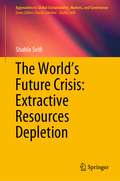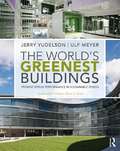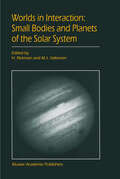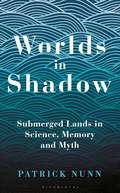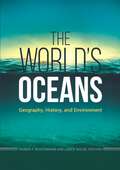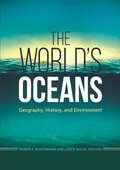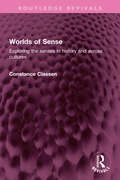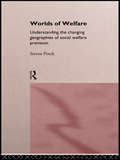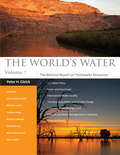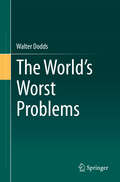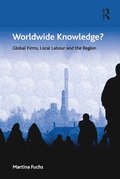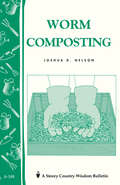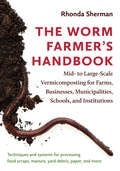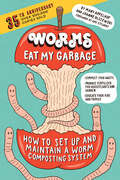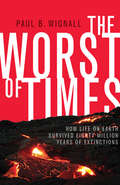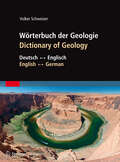- Table View
- List View
The World's Fastest Growing Cities (large print)
by RnibThis page shows a map of the world with ten cities marked. There is a locator dot shown, which will be at the top left, when the image is the correct way up. The image is surrounded by an image border. The sea is shown as a textured area (pale blue on large print image) surrounding the land. There is a small key in the bottom left of the page explaining the textures used on the land. The cities are shown by an open circle symbol. They are: 1 Mexico City 2 Sao Paulo 3 Karachi 4 Delhi 5 Mumbai (Bombay) 6 Kolkata (Calcutta) 7 Dhaka 8 Jakarta 9 Seoul 10 Tokyo
The World's Fastest Growing Cities (UEB contracted)
by RnibThis page shows a map of the world with ten cities marked. There is a locator dot shown, which will be at the top left, when the image is the correct way up. The image is surrounded by an image border. The sea is shown as a textured area (pale blue on large print image) surrounding the land. There is a small key in the bottom left of the page explaining the textures used on the land. The cities are shown by an open circle symbol. They are: 1 Mexico City 2 Sao Paulo 3 Karachi 4 Delhi 5 Mumbai (Bombay) 6 Kolkata (Calcutta) 7 Dhaka 8 Jakarta 9 Seoul 10 Tokyo
The World's Fastest Growing Cities (UEB uncontracted)
by RnibThis page shows a map of the world with ten cities marked. There is a locator dot shown, which will be at the top left, when the image is the correct way up. The image is surrounded by an image border. The sea is shown as a textured area (pale blue on large print image) surrounding the land. There is a small key in the bottom left of the page explaining the textures used on the land. The cities are shown by an open circle symbol. They are: 1 Mexico City 2 Sao Paulo 3 Karachi 4 Delhi 5 Mumbai (Bombay) 6 Kolkata (Calcutta) 7 Dhaka 8 Jakarta 9 Seoul 10 Tokyo
The World’s Future Crisis: Extractive Resources Depletion (Approaches to Global Sustainability, Markets, and Governance)
by Shahla SeifiThis book focuses mainly on strategic decision making at a global level, which is rarely considered in approaches to sustainability. This book makes a unique contribution as the work looks at global consequences of mineral exhaustion and steps that can be taken to alleviate the impending problems. This book highlights how sustainability has become one of the most important issues for businesses, governments and society at large. This book explores the topic of sustainability as one that is under much debate as to what it actually is and how it can be achieved, but it is completely evident that the resources of the planet are fixed in quantity, and once used, cannot be reused except through being reused in one form or another. This is particularly true of the mineral resources of the planet. These are finite in quantity, and once fully extracted, extra quantities are no longer available for future use. This book argues and presents evidence that the remaining mineral resources are diminishing significantly and heading towards exhaustion. Once mined and consumed, they are no longer available for future use other than what can be recycled and reused. This book demonstrates that future scarcity means that best use must be made of what exists, as sustainability depends upon this, and best use is defined as utility rather than economic value, which must be considered at a global level rather than a national level. Moreover, sustainability depends upon both availability in the present and in the future, so the use of resources requires attention to the future as well as to the present. This book investigates the alternative methods of achieving the global distribution of these mineral resources and proposes an optimum solution. This book adds to the discourse through the understanding of the importance of the depletion and finiteness of raw materials and their use for the present and the future, in order to achieve and maintain sustainability.
The World's Greenest Buildings: Promise Versus Performance in Sustainable Design
by Jerry Yudelson Ulf MeyerThe World’s Greenest Buildings tackles an audacious task. Among the thousands of green buildings out there, which are the best, and how do we know? Authors Jerry Yudelson and Ulf Meyer examined hundreds of the highest-rated large green buildings from around the world and asked their owners to supply one simple thing: actual performance data, to demonstrate their claims to sustainable operations. This pivotal book presents: an overview of the rating systems and shows "best in class" building performance in North America, Europe, the Middle East, India, China, Australia and the Asia-Pacific region practical examples of best practices for greening both new and existing buildings a practical reference for how green buildings actually perform at the highest level, one that takes you step-by-step through many different design solutions a wealth of exemplary case studies of successful green building projects using actual performance data from which to learn interviews with architects, engineers, building owners and developers and industry experts, to provide added insight into the greening process This guide uncovers some of the pitfalls that lie ahead for sustainable design, and points the way toward much faster progress in the decade ahead.
The World's Greenest Buildings: Promise Versus Performance in Sustainable Design
by Jerry Yudelson Ulf MeyerThe World’s Greenest Buildings tackles an audacious task. Among the thousands of green buildings out there, which are the best, and how do we know? Authors Jerry Yudelson and Ulf Meyer examined hundreds of the highest-rated large green buildings from around the world and asked their owners to supply one simple thing: actual performance data, to demonstrate their claims to sustainable operations. This pivotal book presents: an overview of the rating systems and shows "best in class" building performance in North America, Europe, the Middle East, India, China, Australia and the Asia-Pacific region practical examples of best practices for greening both new and existing buildings a practical reference for how green buildings actually perform at the highest level, one that takes you step-by-step through many different design solutions a wealth of exemplary case studies of successful green building projects using actual performance data from which to learn interviews with architects, engineers, building owners and developers and industry experts, to provide added insight into the greening process This guide uncovers some of the pitfalls that lie ahead for sustainable design, and points the way toward much faster progress in the decade ahead.
Worlds in Interaction: Proceedings of the Meeting “Small Bodies in the Solar System and their Interactions with the Planets” held in Mariehamn, Finland, August 8–12, 1994
by Hans Rickman M. J. ValtonenPlanet Earth is part of our Galactic environment, not just the product of it, and it is still today influenced by phenomena related to Galactic forces. Specifically, our planet is affected by its near environment, in particular the small bodies in the Solar System. This book reviews the processes which cause the collisions of these small bodies with the Earth as well as the consequences of such collisions. The various articles take the reader through the Galaxy-Solar System connection to the orbital dynamics of the small bodies and to their number and distribution in near-Earth space. The hazards of the impacts of small bodies on Earth are evaluated, and the geophysical records of such impacts are discussed. The book takes the reader to the forefront of research on both impact cratering and the origin and evolution of small bodies in the Solar System. Thus it brings together two subjects, geophysics and astronomy, which are usually discussed in separate volumes but are closely knit together in this particular area of research.
Worlds in Shadow: Submerged Lands in Science, Memory and Myth
by Patrick NunnThe traces of much of human history – and that which preceded it – lie beneath the ocean surface; broken up, dispersed, often buried and always mysterious. This is fertile ground for speculation, even myth-making, but also a topic on which geologists and climatologists have increasingly focused in recent decades. We now know enough to tell the true story of some of the continents and islands that have disappeared throughout Earth's history, to explain how and why such things happened, and to unravel the effects of submergence on the rise and fall of human civilizations. In Worlds in Shadow Patrick Nunn sifts the facts from the fiction, using the most up-to-date research to work out which submerged places may have actually existed versus those that probably only exist in myth. He looks at the descriptions of recently drowned lands that have been well documented, those that are plausible, and those that almost certainly didn't exist. Going even further back, Patrick examines the presence of more ancient lands, submerged beneath the waves in a time that even the longest-reaching folk memory can't touch. Such places may have played important roles in human evolution, but can only be reconstructed through careful geological detective work. Exploring how lands become submerged, whether from sea-level changes, tectonic changes, gravity collapse, giant waves or volcanoes, helps us determine why, when and where land may disappear in the future, and what might be done to prevent it.
The World's Oceans: Geography, History, and Environment
by Rainer F. Buschmann Lance NoldeThis single-volume resource explores the five major oceans of the world, addressing current issues such as sea rise and climate change and explaining the significance of the oceans from historical, geographic, and cultural perspectives.The World's Oceans: Geography, History, and Environment is a one-stop resource that describes in-depth the Arctic, Atlantic, Indian, Pacific, and Southern Oceans and identifies their importance, today and throughout history. Essays address the subject areas of oceans and seas in world culture, fishing and shipping industries through history, ocean exploration, and climate change and oceans. The book also presents dozens of entries covering a breadth of topics on human culture, the environment, history, and current issues as they relate to the oceans and ocean life. Sample entries provide detailed information on topics such as the Bermuda Triangle, Coral Reefs, the Great Pacific Garbage Patch, Ice Melt, Myths and Legends, Piracy, and Whaling. Contributions to the work come from top researchers in the fields of history and maritime studies, including Paul D'Arcy, John Gillis, Tom Hoogervorst, Michael North, and Lincoln Paine. The volume highlights the numerous ways in which Earth's oceans have influenced culture and society, from the earliest seafaring civilizations to the future of the planet.
The World's Oceans: Geography, History, and Environment
by Rainer F. Buschmann and Lance NoldeThis single-volume resource explores the five major oceans of the world, addressing current issues such as sea rise and climate change and explaining the significance of the oceans from historical, geographic, and cultural perspectives.The World's Oceans: Geography, History, and Environment is a one-stop resource that describes in-depth the Arctic, Atlantic, Indian, Pacific, and Southern Oceans and identifies their importance, today and throughout history. Essays address the subject areas of oceans and seas in world culture, fishing and shipping industries through history, ocean exploration, and climate change and oceans. The book also presents dozens of entries covering a breadth of topics on human culture, the environment, history, and current issues as they relate to the oceans and ocean life. Sample entries provide detailed information on topics such as the Bermuda Triangle, Coral Reefs, the Great Pacific Garbage Patch, Ice Melt, Myths and Legends, Piracy, and Whaling. Contributions to the work come from top researchers in the fields of history and maritime studies, including Paul D'Arcy, John Gillis, Tom Hoogervorst, Michael North, and Lincoln Paine. The volume highlights the numerous ways in which Earth's oceans have influenced culture and society, from the earliest seafaring civilizations to the future of the planet.
Worlds of Sense: Exploring the senses in history and across cultures (Routledge Revivals)
by Constance ClassenFirst published in 1993, Worlds of Sense is an exploration of the historical and cultural formation of the senses. As the author demonstrates, different cultures have strikingly different ways of ‘making sense’ of the world. In the modern urban West, we are accustomed to thinking in terms of visual models such as ‘world view,’ whereas the Ongee of the Andaman Islands, for example, live in a world ordered by smell and the Tzotzil of Mexico hold that temperature is the basic force of the cosmos. In a fascinating examination of the role of the senses in diverse societies and eras, Constance Classen shows the extent to which perception is shaped by and expressive of cultural values. This book will be of interest to students of cultural studies, sociology, anthropology, and philosophy.
Worlds of Sense: Exploring the senses in history and across cultures (Routledge Revivals)
by Constance ClassenFirst published in 1993, Worlds of Sense is an exploration of the historical and cultural formation of the senses. As the author demonstrates, different cultures have strikingly different ways of ‘making sense’ of the world. In the modern urban West, we are accustomed to thinking in terms of visual models such as ‘world view,’ whereas the Ongee of the Andaman Islands, for example, live in a world ordered by smell and the Tzotzil of Mexico hold that temperature is the basic force of the cosmos. In a fascinating examination of the role of the senses in diverse societies and eras, Constance Classen shows the extent to which perception is shaped by and expressive of cultural values. This book will be of interest to students of cultural studies, sociology, anthropology, and philosophy.
Worlds of Welfare: Understanding the Changing Geographies for Social Welfare Provision
by Steven PinchThroughout the world welfare systems have been experiencing a period of unprecedented change. Understanding these changes is difficult, not only because of their diversity, but also because they vary so much from place to place. Worlds of Welfare provides a clear and concise guide to these changes. The first part of the book examines the range of different welfare states around the world, describing the various reforms - such as privatisation and commercialisation - which have been introduced in recent years. The second part of the book tests the many theoretical perspectives for understanding such social change. The book concludes with an exploration of the future of the welfare state in multicultural societies. Clearly written, with an extensive glossary of key terms, the book demonstrates how a geographical perspective is crucial to understanding the diversity of welfare reform. Worlds of Welfare will be of interest to all concerned for the future of welfare services.
Worlds of Welfare: Understanding the Changing Geographies for Social Welfare Provision
by Steven PinchThroughout the world welfare systems have been experiencing a period of unprecedented change. Understanding these changes is difficult, not only because of their diversity, but also because they vary so much from place to place. Worlds of Welfare provides a clear and concise guide to these changes. The first part of the book examines the range of different welfare states around the world, describing the various reforms - such as privatisation and commercialisation - which have been introduced in recent years. The second part of the book tests the many theoretical perspectives for understanding such social change. The book concludes with an exploration of the future of the welfare state in multicultural societies. Clearly written, with an extensive glossary of key terms, the book demonstrates how a geographical perspective is crucial to understanding the diversity of welfare reform. Worlds of Welfare will be of interest to all concerned for the future of welfare services.
The World’s Water Volume 7: The Biennial Report on Freshwater Resources (The World’s Water #8)
by Peter H. GleickProduced biennially, The World's Water is the most comprehensive and up-to-to date source of information and analysis on freshwater resources. Each new volume examines critical global trends and offers the best data available on a variety of topics related to water.Volume 7 features chapters on U.S. water policy, transboundary waters, and the effects of fossil fuel production on water resources, among other timely issues. Water briefs provide concise updates on topics including bottled water, The Great Lakes Water Agreement, and the state of the Colorado River.Since the first volume of The World's Water appeared in 1998, the series has become an indispensable resource for professionals in government agencies and nongovernmental organizations, researchers, students, and anyone concerned with water and its use.
The World's Worst Problems
by Walter DoddsThis book addresses the worst problems currently facing humanity and those that may pose future threats. The problems are explained and approached through a scientific lens, and categorized based on data involving global mortality, vulnerability, and threat level. The book presents indices of problem severity to compare relative intensity of current and potential crises. The approach avoids emotional argument using mainly empirical evidence to support the classification of relative problem severity. The author discusses multiple global problems and ranks them. He also explores specific solutions to each problem, links problems to human behavior from a social science perspective, considers international cooperation, and finally pathways to solutions.The book discusses confirmation bias and why this necessitates a scientific approach to tackle problems. The moral assumption that each person has the same rights to life and minimal suffering, and that the natural world has a right to exist, forms the basis of ranking problems based on death, suffering, and harm to the natural world. A focus is given to potential disasters such as asteroid collisions and super-volcanic eruptions, which are then presented in chapters that address specific contemporary global issues including disease, hunger, nuclear weapons and climate change. Furthermore the author then ranks the problems based on an index of problem severity, considering what other people think the worst problems are. The relative economic costs to solve each of these problems, individual behavior in the face of these problems, how people could work together internationally to combat them, and a general pathway toward solutions form the basis of the final chapters. This work will appeal to a wide range of readers, students considering how they can help the world, and scientists and policy makers interested in global problem solving.
Worldwide Knowledge?: Global Firms, Local Labour and the Region (Economic Geography Series)
by Martina FuchsPutting forward a comprehensive view of knowledge with a specific perspective on place and space, this book provides a new perspective on the globalisation of knowledge. Crossing disciplinary boundaries, the principal agenda of this volume is to open up a perspective ’beyond knowledge’ - i.e. beyond the interpretation of knowledge as scientific-technical knowledge. Author Martina Fuchs introduces further kinds of knowledge and interpretation which influence managements’ perception of globalisation and therefore the knowledge which is going global. She refers to knowledge in the sense of experiences, competencies in the production and labour process, as well as mutually shared mental constructs which are embedded in a context of understanding and interpretation. Exploring beyond the meaning of worldwide knowledge as general open access knowledge, this book also discusses barriers to knowledge, problems of transfer, and the influence of governance and control.
Worldwide Knowledge?: Global Firms, Local Labour and the Region (Economic Geography Series)
by Martina FuchsPutting forward a comprehensive view of knowledge with a specific perspective on place and space, this book provides a new perspective on the globalisation of knowledge. Crossing disciplinary boundaries, the principal agenda of this volume is to open up a perspective ’beyond knowledge’ - i.e. beyond the interpretation of knowledge as scientific-technical knowledge. Author Martina Fuchs introduces further kinds of knowledge and interpretation which influence managements’ perception of globalisation and therefore the knowledge which is going global. She refers to knowledge in the sense of experiences, competencies in the production and labour process, as well as mutually shared mental constructs which are embedded in a context of understanding and interpretation. Exploring beyond the meaning of worldwide knowledge as general open access knowledge, this book also discusses barriers to knowledge, problems of transfer, and the influence of governance and control.
Worm Composting: Storey's Country Wisdom Bulletin A-188 (Storey Country Wisdom Bulletin)
by Joshua D. NelsonSince 1973, Storey's Country Wisdom Bulletins have offered practical, hands-on instructions designed to help readers master dozens of country living skills quickly and easily. There are now more than 170 titles in this series, and their remarkable popularity reflects the common desire of country and city dwellers alike to cultivate personal independence in everyday life.
The Worm Farmer’s Handbook: Mid- to Large-Scale Vermicomposting for Farms, Businesses, Municipalities, Schools, and Institutions
by Rhonda ShermanTechniques and systems for processing food scraps, manure, yard debris, paper, and more Turning waste into wealth sounds too good to be true, but many worm farmers are finding that vermicomposting is a reliable way to do just that. Vermicast—a biologically active, nutrient-rich mix of earthworm castings and decomposed organic matter—sells for $400 or more per cubic yard. Compare that to regular compost, sold at about $30 a cubic yard, and you’ll see why vermicomposting has taken root in most countries and on every continent but Antarctica. Vermicomposting is also one of the best sustainable solutions for organic waste management. Vermicomposting manure and crop wastes on farms improves crop yields while reducing demand for off-farm inputs. Vermicast has higher nutrient levels and lower soluble salt content than regular compost, and it improves soil aeration, porosity, and water retention. Plus, vermicast suppresses plant diseases and insect attacks. Municipalities, businesses, community gardens, schools, and universities can set up vermicomposting operations to process food residuals and other waste materials. The Worm Farmer’s Handbook details the ins and outs of vermicomposting for mid- to large-scale operations, including how to recycle organic materials ranging from food wastes and yard trimmings to manure and shredded office paper. Vermicomposting expert Rhonda Sherman shares what she has learned over twenty-five years working with commercial worm growers and researchers around the world. Her profiles of successful worm growers across the United States and from New Zealand to the Middle East and Europe describe their proven methods and systems. This book digs into all the details, including: Choosing the right production system Regulatory issues and developing a business and marketing plan Finding and managing feedstocks Pre-composting: why and how to do it Monitoring an active worm bed Harvesting, screening, testing, packaging, and storing vermicast Markets for earthworms and vermicast Food security: how vermicast benefits soils and plants Keys to success: avoiding common pitfalls From livestock farms and restaurants to colleges, military bases, and prisons, Sherman details why and how commercial-scale vermicomposting is a fast-growing, sustainable solution for organic waste management. The Worm Farmer’s Handbook is the first and only authoritative how-to guide that goes beyond small-scale operations and demystifies the science and logistics of the fascinating process that is vermicomposting.
Wormholes, Warp Drives and Energy Conditions (Fundamental Theories of Physics #189)
by Francisco S. LoboTop researchers in the field of gravitation present the state-of-the-art topics outlined in this book, ranging from the stability of rotating wormholes solutions supported by ghost scalar fields, modified gravity applied to wormholes, the study of novel semi-classical and nonlinear energy conditions, to the applications of quantum effects and the superluminal version of the warp drive in modified spacetime. Based on Einstein's field equations, this cutting-edge research area explores the more far-fetched theoretical outcomes of General Relativity and relates them to quantum field theory. This includes quantum energy inequalities, flux energy conditions, and wormhole curvature, and sheds light on not just the theoretical physics but also on the possible applications to warp drives and time travel.This book extensively explores the physical properties and characteristics of these 'exotic spacetimes,' describing in detail the general relativistic geometries that generate closed timelike curves.
Worms Eat My Garbage, 35th Anniversary Edition: How to Set Up and Maintain a Worm Composting System: Compost Food Waste, Produce Fertilizer for Houseplants and Garden, and Educate Your Kids and Family
by Mary Appelhof Joanne OlszewskiFor more than three decades, this best-selling guide to the practice of vermicomposting has taught people how to use worms to recycle food waste into nutrient-rich fertilizer for houseplants or gardens. Small-scale, self-contained worm bins can be kept indoors, in a basement, or even under the kitchen sink in an apartment — making vermicomposting a great option for city dwellers and anyone who doesn&’t want or can&’t have an outdoor compost pile. The fully revised 35th anniversary edition features the original&’s same friendly tone, with up-to-date information on the entire process, from building or purchasing a bin (readily available at garden supply stores) to maintaining the worms and harvesting the finished compost.
The Worst of Times: How Life on Earth Survived Eighty Million Years of Extinctions
by Paul B. WignallTwo hundred sixty million years ago, life on Earth suffered wave after wave of cataclysmic extinctions, with the worst wiping out nearly every species on the planet. The Worst of Times delves into the mystery behind these extinctions and sheds light on the fateful role the primeval supercontinent, known as Pangea, might have played in causing these global catastrophes. Drawing on the latest discoveries as well as his own firsthand experiences conducting field expeditions to remote corners of the world, Paul Wignall reveals what scientists are only now beginning to understand about the most prolonged and calamitous period of environmental crisis in Earth's history. Wignall shows how these series of unprecedented extinction events swept across the planet, killing life on a scale more devastating than the dinosaur extinctions that would follow. The Worst of Times unravels one of the great enigmas of ancient Earth and shows how this ushered in a new age of vibrant and more resilient life on our planet.
The Worst of Times: How Life on Earth Survived Eighty Million Years of Extinctions
by Paul B. WignallTwo hundred sixty million years ago, life on Earth suffered wave after wave of cataclysmic extinctions, with the worst wiping out nearly every species on the planet. The Worst of Times delves into the mystery behind these extinctions and sheds light on the fateful role the primeval supercontinent, known as Pangea, might have played in causing these global catastrophes. Drawing on the latest discoveries as well as his own firsthand experiences conducting field expeditions to remote corners of the world, Paul Wignall reveals what scientists are only now beginning to understand about the most prolonged and calamitous period of environmental crisis in Earth's history. Wignall shows how these series of unprecedented extinction events swept across the planet, killing life on a scale more devastating than the dinosaur extinctions that would follow. The Worst of Times unravels one of the great enigmas of ancient Earth and shows how this ushered in a new age of vibrant and more resilient life on our planet.
Wörterbuch der Geologie / Dictionary of Geology: Deutsch - Englisch/English - German
by Volker SchweizerWissenschaftliche Publikationen werden heute fast nur noch in Englisch verfasst. Sowohl für das Verständnis englischsprachiger Fachliteratur als auch für das Verfassen eigener Publikationen braucht man dringend ein verlässliches Fachwörterbuch. Auch Wissenschaftlern, deren Muttersprache nicht Deutsch ist, wird es für das Verständnis deutschsprachiger Literatur eine große Hilfe sein. Volker Schweizer hat sich als erfahrener Übersetzer großer geologischer Lehrbücher eine hohe Kompetenz erworben und dieses Wörtebuch zusammengestellt.

